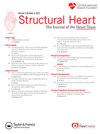Impact of Baseline Anteroposterior Mitral Annular Dimensions on Clinical Outcomes after MitraClip for Secondary Mitral Regurgitation
IF 2.8
Q3 CARDIAC & CARDIOVASCULAR SYSTEMS
引用次数: 0
Abstract
Background
In the randomized Cardiovascular Outcomes Assessment of the MitraClip Percutaneous Therapy for Heart Failure Patients with Functional Mitral Regurgitation (COAPT; NCT01626079) trial, mitral transcatheter edge-to-edge repair (M-TEER) improved clinical outcomes in patients with severe secondary mitral regurgitation (MR). A prior post hoc analysis from the COAPT trial showed that increasing anteroposterior mitral annular diameter (APMAD) was the sole independent echocardiographic predictor of the composite endpoint of death or heart failure hospitalizations (HFH) at 2 years. Given the relationship between the mitral annulus and leaflets, we examined the association of baseline APMAD with long-term clinical outcomes.
Methods
COAPT patients (n = 575) were stratified into tertiles by baseline APMAD as follows: small APMAD, medium APMAD, and large APMAD. APMAD was measured in the anteroposterior direction from the parasternal long-axis view at end-diastole and in the intercommissural direction from the apical two-chamber view.
Results
Patients with larger baseline APMAD were more often male and had fewer comorbidities, larger ventricles, and larger mitral orifice areas. At 2 years, there were no significant differences in MR severity and the composite endpoint of death or HFH in patients treated with M-TEER by baseline APMAD. In patients treated with guideline-directed medical therapy (GDMT) alone, there were no significant differences in MR severity, but the composite endpoint of death or HFH was higher in patients with the largest baseline APMADs. The treatment effect of M-TEER was consistent among APMAD tertiles (pinteraction = 0.87).
Conclusions
APMAD was a predictor of adverse outcomes in patients treated with GDMT alone. M-TEER reduced MR severity and the risk of death or HFH regardless of baseline APMAD compared with GDMT alone.
二尖瓣前后环基线尺寸对二尖瓣夹闭治疗继发性二尖瓣返流后临床结果的影响
背景:米特拉普经皮治疗心力衰竭合并功能性二尖瓣反流(COAPT;NCT01626079)试验表明,二尖瓣经导管边缘到边缘修复(M-TEER)改善了严重继发性二尖瓣反流(MR)患者的临床结果。先前COAPT试验的事后分析显示,二尖瓣前后环直径(APMAD)的增加是2年死亡或心力衰竭住院(HFH)复合终点的唯一独立超声心动图预测因子。考虑到二尖瓣环和小叶之间的关系,我们研究了基线APMAD与长期临床结果的关系。方法575例scoapt患者按APMAD基线分为APMAD小组、APMAD中组和APMAD大组。APMAD在舒张末期胸骨旁长轴位测量正位方向,在根尖双腔位测量关节间方向。结果基线APMAD较大的患者多为男性,合并症较少,心室和二尖瓣面积较大。在2年时,采用M-TEER治疗的患者在MR严重程度和死亡或HFH的综合终点方面没有显著差异。在仅接受指南导向药物治疗(GDMT)的患者中,MR严重程度无显著差异,但基线APMADs最大的患者的死亡或HFH复合终点较高。M-TEER的处理效果在APMAD三萜中一致(p互作= 0.87)。结论sapmad是单独使用GDMT治疗患者不良结局的预测因子。与单独使用GDMT相比,M-TEER降低了MR严重程度和死亡或HFH的风险,无论基线APMAD如何。
本文章由计算机程序翻译,如有差异,请以英文原文为准。
求助全文
约1分钟内获得全文
求助全文
来源期刊

Structural Heart
Medicine-Cardiology and Cardiovascular Medicine
CiteScore
1.60
自引率
0.00%
发文量
81
 求助内容:
求助内容: 应助结果提醒方式:
应助结果提醒方式:


